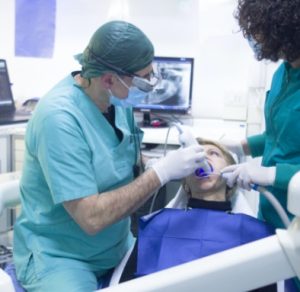A common side effect associated with advanced, untreated periodontal disease is bone loss of the jaw. When this occurs, your dentist will often suggest having a bone graft – a minor surgical procedure which helps the growth of new bone. Typically, bone grafts are taken from elsewhere in the body. Alternatively, they come from donors, animals or are made out of synthetic materials. Usually, material used to make bone grafts will consist of processed bone minerals which assist your body to create fresh bone cells over time.
Some people cannot have bone grafting procedures, however, including:
- Anybody suffering from active infections
- Anybody who is immunocompromised or with an immune deficiency
- Anybody receiving radiation or chemotherapy treatments
- Anybody who is either pregnant or breastfeeding
Bone Loss/Gum Disease
Periodontitis, also called periodontal disease, describes an advanced form of gum disease that causes permanent damage to the bones, gums and their surrounding tissues. As time goes on, plaque and tartar will build up and this causes periodontitis to develop. This causes irritation of the gums which will begin to separate from the teeth. As a result, periodontal pockets form below the gum line, in which plaque and tartar will collect. Should the patient then fail to get their teeth cleaned professionally, the disease will eventually cause a loss of soft tissue and bone. Since the body won’t naturally grow new bone cells, a bone graft will be the one effective way to treat periodontal disease once this stage has been reached.
Bone Grafts For Dental Implants
Bone grafts don’t just repair damaged bone, they also help to save teeth from being lost. If periodontitis causes tooth loss, a dental implant may be placed after bone grafts have healed. Dental implants are artificial teeth with a shape like a screw. They bond with the natural bone in the patient’s jaw and, for this reason, enough strong and healthy bone needs to remain in the patient’s jaw for implants to be successfully placed.
What Types Of Bone Graft Are There?
Patients can benefit from four types of periodontal bone graft:
Autografts
If the patient’s natural bone is used for carrying out their bone graft, this is called an autograft. Typically, the bone is taken either from the back of their jaw bone or from their hip bone. Not every patient can have this type of graft. Also, the patient often suffers pain around the area from which the donor bone has been taken, causing problems for some patients. Typically, synthetic, cadaver or animal grafting materials are used by periodontists, with grafts only being taken from a patient in very severe cases. The average cost of autografts is between $700 – $1000 for just one area.
Allografts
A patient who can not have an autograft for any reason can have allografts instead. These involve the use of human bone taken from cadavers. This procedure is safe and more affordable and also comes with a reduced risk of infection. Allografts cost around $700 – $1000.
Xenografts
These bone grafts use bone that has been taken from an animal (typically a cow). Although this procedure is often successfully, it is less likely to succeed than an autograft or allograft procedure as the bone has been taken from a different species. A xenograft doesn’t stimulate a patient’s body to produce new bone cells. Instead, it creates a kind of scaffold so the bone can grow naturally into it. Often, some of this type of bone graft becomes the patient’s bone too. A xenograft will cost around $700 – $1000.
Alloplasts
An alloplast uses a synthetic bone substitute made from phosphorus, hydroxylapatite and calcium. There is no chance of disease transmission during this procedure and any small defect will heal by itself. Similar to xenografts, an alloplast won’t stimulate new bone cells to be produced by the patient’s body. This type of procedure costs between $700 – $1000.
Sinus Lift Surgery: Before, During & After the Procedure
If a patient has lost some back teeth, it’s possible their sinus will begin falling to fill the gaps caused by their missing teeth. If this occurs a dental sinus lift represents a good solution. A sinus lift restores the sinus of the patient to normal as the gap is repaired with a bone graft. Having sinus lift surgery as well as placement of dental implants costs between $3000 – $6000.
Patients receive a general anesthetic before they undergo a bone grafting procedure so they fall asleep and feel no pain during surgery. After a few hours, the medication will wear off and, although some pain is normal after the procedure, it diminishes within a few days. Patients will experience discomfort for several weeks though, and eating only soft foods like cooked vegetables, oatmeal, mashed potato, smoothies and scrambled egg is vital while their mouth is healing. Usually, bone grafts heal completely within just four to six weeks.
Some side effects are associated with bone grafting procedures including:
- Swollen gums
- Skin swelling and bruising
- Minor bleeding
- Issues with eating, chewing and speaking
In some cases, bone grafts result in health issues like:
- An adverse reaction to the anesthetic during the procedure
- Pain, inflammation and swelling around either the donor or grafting site
- Bleeding and infection
- Nerve injuries
- Reabsorption of the graft
- Rejection of the graft

